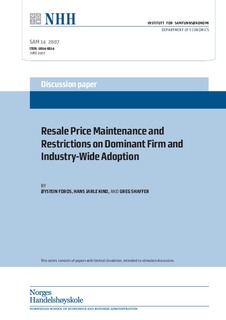| dc.contributor.author | Foros, Øystein | |
| dc.contributor.author | Kind, Hans Jarle | |
| dc.contributor.author | Shaffer, Greg | |
| dc.date.accessioned | 2007-09-21T11:17:49Z | |
| dc.date.available | 2007-09-21T11:17:49Z | |
| dc.date.issued | 2007-06 | |
| dc.identifier.issn | 0804-6824 | |
| dc.identifier.uri | http://hdl.handle.net/11250/163034 | |
| dc.description.abstract | This paper examines the use of market-share thresholds (safe harbors)
in evaluating whether a given vertical practice should be challenged. Such
thresholds are typically found in vertical restraints guidelines (e.g., the 2000 Guidelines
for the European Commission and the 1985 Guidelines for the U.S. Department
of Justice). We consider a model of resale price maintenance (RPM) in which firms
employ RPM to dampen downstream price competition. In this model, we find
that restrictions on the use of RPM by a dominant firm can be welfare improving,
but restrictions on the extent of the market that can be covered by RPM (i.e., the
pervasiveness of the practice among firms in the industry) may lead to lower welfare
and higher consumer prices than under a laissez-faire policy. Our results thus call
into question the indiscriminate use of market-share thresholds in vertical cases. | en |
| dc.language.iso | eng | en |
| dc.publisher | Norwegian School of Economics and Business Administration. Department of Economics | en |
| dc.relation.ispartofseries | Discussion paper | en |
| dc.relation.ispartofseries | 2007:14 | en |
| dc.subject | vertical restraints | en |
| dc.subject | safe harbors | en |
| dc.subject | antitrust policy | en |
| dc.title | Resale price maintenance and restrictions on dominant firm and industry-wide adoption | en |
| dc.type | Working paper | en |
| dc.subject.nsi | VDP::Samfunnsvitenskap: 200::Økonomi: 210::Samfunnsøkonomi: 212 | en |
